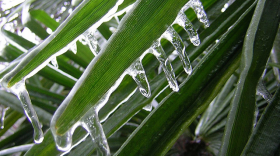The world-famous ghost orchid is blooming at Audubon Florida’s Corkscrew Swamp Sanctuary, which is a highlight of each year for orchid lovers who flock to the popular nature preserve east of Naples.
It’s the largest known ghost orchid in the world, but that’s relative, because even as it’s nearing full bloom right now binoculars are a must to see the one-of-a-kind flower up close.
Keith Laakkonen, Corkscrew Swamp’s director, is often out with first-time orchid onlookers helping them locate the inches-wide flower, which is high up in a tree several dozen yards from the boardwalk above the swamp.
"They think that the ghost orchid is going to be this three-or-four-feet across orchid, and it's actually very small and very delicate,” he said. “When they do see it, you hear an ‘ohhhh.’ You hear this breath. You hear a gasp. You hear silence as they sort of absorb the moment they see the orchid. It’s really a special time."

When it blooms, the rare orchid seems to appear from nowhere and float in the air next to its host tree, but it’s there all the time. When not in bloom, the orchid has no leaves and grows tucked up close to its host tree, its roots camouflaged.
Summer rains and humidity often cause the flower to burst forth. At the same time it holds on to its host tree with wispy tendrils that can’t be seen from far away, which gives the orchid the appearance of floating next the tree, ghost-like.
Orchid lovers are known to be a passionate group, so attendance spikes at the sanctuary every time the normally-dormant orchid blooms. Some orchid fans even come from overseas, every year.
A species in peril
In addition to Corkscrew Swamp, wild ghost orchids in Florida can be found in the Big Cypress National Preserve, Florida Panther National Wildlife Refuge, Fakahatchee Strand Preserve State Park, and within tribal areas and conservation areas in Collier, Hendry, and possibly Lee counties. It is also found in Cuba.
But outside of the protected sanctuary, climate change, development, poaching, and weather events are reducing the number of ghost orchids to worrisome levels.

Some of the Everglades’ ghost orchids were lost during Hurricane Ian’s onslaught on South and Central Florida last September, but nobody knows exactly how many were hurricaned-to-death.
Rampant poaching of ghost orchids to feed a black market for the flower also removes a certain number from the wild.
International theft of rare or newly discovered orchids happens not so much because the poacher finds the inherent beauty of the flower irresistible, but because in their imagination the gorgeous coloring of a new or special flower has figurative dollar signs on its leaves.
Propagation of a particularly notable, new, or gorgeous flower can be both lucrative and prestigious.
Even professional orchid scientists have run afoul of federal laws concerning the importation of orchids from abroad.
Several orchidologists associated with Marie Selby Botanical Gardens in downtown Sarasota became embroiled in international intrigue that ended with the institution itself and a retired orchid collector from Vermont pleading guilty in a federal courtroom in Tampa.
Climate change, habitat loss, hurricanes, and poaching combined have lowered estimates of the number of ghost orchids in the wild at about 1,000, a population so low that it is raising concerns about the flower's ability to exist in the future.
Protection delayed
Federal and state wildlife officials said one year ago the stealthy, rare, and beautiful flower may very well be added to the Endangered Species List by year's end.
The Fish and Wildlife Service is the federal agency able to grant Endangered Species Act protection to the ghost orchid, already a critically endangered flower. Under federal law, the agency had about three months to make the call.
But the agency missed its deadline, leaving environmental groups fighting to save the flowers livid.

“The U.S. Fish and Wildlife Service has missed the statutory deadline to make a decision on protecting the iconic ghost orchid, leaving the species in a regulatory limbo without crucial safeguards,” the Center for Biological Diversity wrote in a release in January. “Currently the service is not scheduled to make a decision until 2026.”
The center said two people allegedly took a ghost orchid, and other rare orchids and air plants, from Fakahatchee Strand late last year. Police found a machete and a bag filled with more than 30 rare and endangered plants.
“This disastrous federal delay comes as the ghost orchid struggles to survive human greed and a multitude of other threats,” said Elise Bennett, Florida director for the Center for Biological Diversity. “Endangered Species Act protection is crucial to give this hauntingly beautiful orchid a fighting chance at beating extinction. For one thing, it would impose stronger penalties for poachers. The Fish and Wildlife Service’s foot-dragging is depriving the orchid of crucial protection.”
RELATED ORCHID NEWS: Two Clyde Butcher images at Chelsea Flower Show


Wilderness photographer Clyde Butcher was invited to be part of "ORCHID CONSERVATION — Finding the Rare Florida Ghost Orchid" as part of the Orchid Conservation Collaborative Display at the Chelsea Flower Show in England. An Everglades setting was replicated at the show that included a live Florida ghost orchid and two of Butcher's large-form photos, Ghost Orchid 2 and Cigar Orchid Pond, above. See this link for a time-lapse view of the exhibit's installation.
Environmental reporting for WGCU is funded in part by VoLo Foundation, a non-profit with a mission to accelerate change and global impact by supporting science-based climate solutions, enhancing education, and improving health.
Sign up for WGCU's monthly environmental newsletter, the Green Flash, today.
WGCU is your trusted source for news and information in Southwest Florida. We are a nonprofit public service, and your support is more critical than ever. Keep public media strong and donate now. Thank you.








